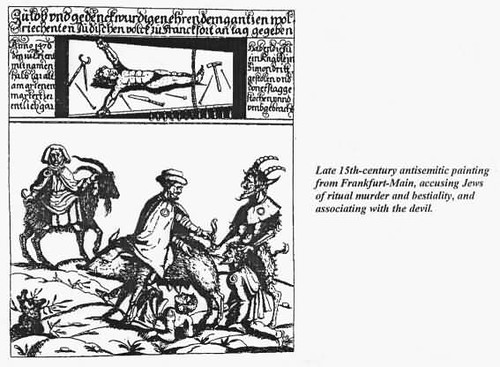
I have spent a huge amount of my life attempting to understand how prejudice works. And what's amazing is the stories we tell to distinguish "us" from "them" never change. "They" kill babies, desecrate our religious symbols, rape our women, castrate our men. "They" have no respect for life, and are fanatics, and will kill for their beliefs. "We" are never safe because they are invisible. So we must mark them so that we can see them, and once we can see them, we can destroy them.
Jo and I were in graduate school together, and Jo did brilliant work on how Jews came to be branded in Christian Europe as ritual murderers. I was fascinated by accusations of witchcraft, because I wanted to understand what role gender and religion played in the formation of prejudice.
While I was an academic, I increasingly intellectualized the problem. Here's a precis for a paper I gave:
"Suffer the Children: Representations of Ritual Infanticide in Renaissance Europe"
Lorraine Berry, Department of History
Beginning in the Quattrocentro, a proliferation of fantastical images appeared in both Italy and Germany, illustrating the imaginary ritual killing of children. One set of illustrations depicted, in lurid detail, the centuries-old charge of ritual murder/blood libel against the Jews. The second set of representations portrayed women killing children while present at the witches' sabbath. In this paper, I want to look specifically at a limited number of these visual representations. Ranging from Florence in 1475 to Germany in the late sixteenth century, these woodcuts helped to disseminate the twin discourses of ritual infanticide. I will argue that these representations of ritual infanticide were both the products and producers of discourses of abjection whose social effect was the instantiation of the Christian subject. Employing the theories of such feminist writers as Kristeva, Butler, and de Lauretis, I will show how the very images of ritual infanticide themselves, while depicting the "Other" engaged in acts of violence against children, also served as discomfiting parables for their Christian audiences. While unarticulated, these images functioned to remind observers of their own relationship to the abject.
Note the intellectual distance, the attempt to layer language between myself and my topic. What I wanted to do was to stand before the audience and scream, "Look at what propaganda looks like! Look at how it was used to incite hatred--which inevitably led to murder--against groups of people who were regarded as the internal enemy." But screaming at your audience in academia is not considered cool.
But I also wanted to point out that the things we fear in the Other are the things we claim are not ours. We do not torture, or rape, or rip fetuses from their mothers' wombs and claim them as our own, or lynch, or threaten children (who are having to be escorted by the National Guard) on their way to school. (And no, I'm not providing links. The documents are out there.)
And one of the major fears, which comes up over and over again, is that somehow we're going to mix with them. The Fourth Lateran Council in 1215 decreed that Jews needed to wear a distinguishing circle on their clothes. Why? In order to prevent their men sleeping with Christian women or Jewish women seducing Christian men. The history of fears of "miscegnation" in American history is encyclopedic. Ask Emmett Till what happens to an African American boy who dares to whistle at a Caucasian woman.

So, 44 percent of Americans think that Muslim Americans should have their rights restricted. In the meantime, we can trust the mainstream media to present us with lurid images of death and destruction, intimate that "they" did it. And the ranks of them are getting larger. If you have been following the news of late, the only people who can be trusted to safeguard our morals are born-again Christians. The rest of us don't count. You don't need to have me repeat Niemoller's warning. You should know it by heart.
I don't mean to lecture. I really don't. It's more of a howl in the dark.
I sit here and want to cry. As it was in the beginning, so shall it be in the end.
1 comment:
Awesome blog. I'm just starting on mine. Yours is a good role model. Keep the faith.
Post a Comment